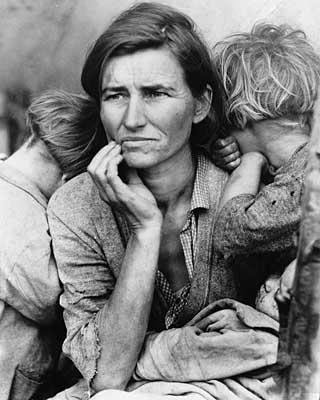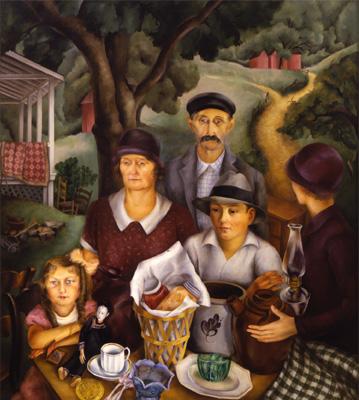Lesson Description
This Lesson uses pieces from the Newark Museum and NEH to enhance students understanding of the Great Depression and Great Recession. By the end of this lesson children should be able to answer the following essential questions:
• What were the causes and effects of the Great Depression and Great Recession?
• How did people experience and respond to these events?
• How were the Great Depression and Great Recession similar and different?
• How did the federal government respond in the Great Depression and Great Recession?
• In what ways were these responses similar and different?
• What avenues were used to convey various attitudes and experiences during these periods?
Objectives
Students will be able to:
• Compare and contrast the Great Depression and the Great Recession.
• Draw conclusions about how people were affected by and reacted to the Great Depression and Great Recession.
Materials
• Venn diagram with “So what?” line
• Great Depression and Great Recession recap sheet—“Do Now”
• Worksheet for the pictures and articles
• The Great Crash 1929 by John Kenneth Galbraith
• Excerpts from Hard Times by Studs Terkel
• Bad Money by Kevin Phillips
• Great Depression pictures from Library of Congress
• Great Depression pictures from Franklin D. Roosevelt’s Presidential Library
Vocabulary
Leverage
the use of a small initial investment, credit, or borrowed funds to gain a very high return in relation to one’s investment, to control a much larger investment, or to reduce one’s own liability for any loss.
Bubble
an inflated speculation, especially if fraudulent: ex. The real estate bubble ruined many investors.
Speculation
engagement in business transactions involving considerable risk but offering the chance of large gains, especially trading in commodities, stocks, etc., in the hope of profit from changes in the market price.
Regulation
a law, rule, or other order prescribed by authority, epically to regulate conduct.
Deregulation
to remove government regulatory controls from (an industry, a commodity, etc.): to deregulate the trucking industry; to deregulate oil prices.
Mortgages, mortgage-backed securities
a conveyance of an interest in property as security for the repayment of money borrowed.
Stocks
the outstanding capital of a company or corporation. (Dictionary.com)
Bonds
a negotiable certificate that acknowledges the indebtedness of the bond issuer to the holder.
Inflation
a persistent, substantial rise in the general level of prices related to an increase in the volume of money and resulting in the loss of value of currency.
Deflation
a fall in the general price level or a contraction of credit and available money.
Dust Bowl
or the dirty thirties was a period of severe dust storms causing major ecological and agricultural damage to American prairie lands in the 1930s.
Migration
the process or act of migrating. To go from one country, region, or place to another.
“Okies”
a term dating from as early as 1907, originally denoting a resident or native of Oklahoma. In the 1930s in California the term (often in contempt) came to refer to very poor immigrants from Oklahoma (an nearby states).
Procedures
Introduction
Do now—students will complete the worksheet “What I remember about the Great Recession” and the K-W-L chart for the Great Depression. (those will be distributed to each student)
Go over and review the causes and effects of the Great Recession, what has been learned about the Great Depression thus far (Hoover, FDR, dust bowl, stock market collapse, wide disparity between the rich and poor, leverage and margin buying, etc.)
Art Connection
1. Use the Migrant Mother photograph with the entire class. Ask them to make observations about the photograph, and write them down. Then ask them what they saw. Go over the observations as a class. Direct the students to be able to gain information and draw conclusions about the Great Depression from this famous photograph.
2. Introduce activity using Great Depression and Great Recession pictures, articles, and excerpts from Hard Times by Studs Terkel (Distribute worksheet to class). Instruct students to work in groups of two (assign pairs). Students will be assigned Great Depression and Great Recession materials, and must answer the questions from the worksheet pertaining to their respective materials. When students are finished, they will present their findings to the class, while their peers take notes on the presenters’ content. Each group will be an “expert” that will teach their section to the class.
3. When each group is finished presenting, a Venn diagram with a “So what?” line will be distributed. Each student will use the Venn diagram to compare and contrast the Great Depression and Great Recession. The “So what?” line is a mechanism to help students draw conclusions and synthesize information from the comparing and contrasting segment in a way that brings together and summarizes what they just did in the Venn diagram in a way that would invite higher-level critical thinking.
4. Students will use the Newark Museum painting At the Country Auction (1935) for an activity that could help assess their grasp thus far of the Great Depression and Great Recession. Students will pretend they are working for a newspaper or news website in 2009, and they have the ability to step into a time machine and go back in time to report on how the Great Depression was affecting families. They would have to create a title, followed by either an article or a weblog (student option). They would have to use the information that they have learned about the Great Depression and Great Recession and make connections between both events.
Resources
Picturing America Image:
Dorothea Lange
Migrant Mother (1936)
Black-and-white photograph
Library of Congress Collection

Picturing America Image:
Charles Sheeler
American Landscape (1930)
Oil on Canvas
Museum of Modern Art Collection
Newark Museum Image:
Minetta Good
At the Country Auction (1935)
Oil on Canvas
Newark Museum Collection

Newark Museum Image:
Reginald Marsh
Alma Mater (1933)
Oil on canvas painting
Newark Museum Collection

Assessment
Possible Writing Topics Post Lesson To Gage Students Learning:
- Using web video from the New York Times website showing stories of various people experiencing hardship during the Great Recession
- Comparing and contrasting the federal government’s response to both crises by examining FDR’s New Deal and the Bush/Obama financial bailout and Obama’s stimulus plan.
- Analyze the bailout plan using the list of banks and institutions receiving bailout funds (New York Times) and compare them to names of the largest campaign contributors in the 2004 and 2008 presidential elections (opensecrets.org—information for Bush, Kerry, Obama, and McCain’s presidential campaigns).
- Contrast the radicalization of the Great Depression amongst population segments with a more moderate and passive response during the Great Recession.
- Evaluate the New Deal’s legacy. Examine John Maynard Keynes, Milton Friedman, and other economist/historian interpretations.

Any views, findings, conclusions, or recommendations expressed in this publication does not necessarily reflect those of the National Endowment for the Arts.





